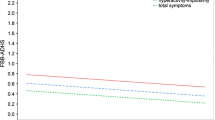Abstract
At the age of 16–18 years, outcome was prospectively assessed in a general population sample of four behavioural groups, defined at 6–7 year old: a pure pervasively hyperactive group (N=31), a mixed hyperactive conduct problem group (N=20), a pure conduct problem group (N=18) and a normal control group (N=29). The objective of the present paper is to describe outcome in those domains for which self-report is recognised as a valid source of information. Differential effects for hyperactivity and conduct problems on outcome were studied. It was found that early hyperactivity and conduct problems predicted different patterns of conduct problems in adolescence. Drug use in adolescence was not predicted by either type of behavioural problem in childhood. Overall social adjustment was worse in the hyperactive groups, whereas no differences in self-esteem were found. Hyperactivity was a strong predictor of relationships problems in adolescence. The results suggest that hyperactivity and conduct problems in childhood are differential predictors of outcome in adolescence.
Similar content being viewed by others
Author information
Authors and Affiliations
Additional information
Accepted: 28 April 1999
Rights and permissions
About this article
Cite this article
Danckaerts, M., Heptinstall, E., Chadwick, O. et al. A natural history of hyperactivity and conduct problems: self-reported outcome. European Child & Adolescent Psychiatry 9, 26–38 (2000). https://doi.org/10.1007/s007870050113
Issue Date:
DOI: https://doi.org/10.1007/s007870050113




